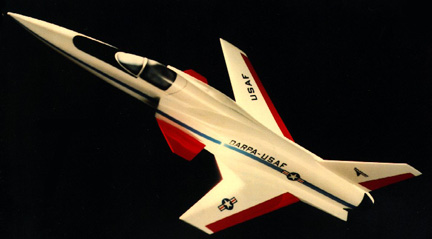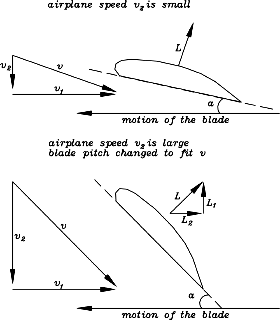(22a) Airplane Flight
Basics of AviationAirplanes are held up by the way air pressure rearranges itself when air flows over the wing of an airplane.
With the airplane in flight, an air flow passes over the wing, and the shape of the wing's cross section--curved above, flat or nearly flat below--reduces the pressure on top, causing the extra pressure from below to exert a lifting force ("lift"). The lift increases if the front of the wing is raised slightly, biting into the moving air at a small angle ("angle of attack"), and for a given lifting force, this kind of wing produces much less air resistance ("drag") than a flat kite.
Frames of ReferenceBut wait a moment--isn't it the airplane that is moving, not the air?Depends on one's frame of reference! In the frame of the air or the ground, the airplane is indeed in motion. But one could also calculate everything in the frame of the airplane, where it is the air that is moving. As long as the airplane flies in a straight line with constant velocity, the same laws apply.
To test how a wing will perform in flight, instead of making it move in still air, one may equally well mount it in a laboratory and blow over it a stream of air. The physical processes are the same. That is the principle of the Wind Tunnel--a box with a fan that blows air into it (or better, sucks it out, which produces a smoother flow), inside which wing sections can be mounted and tested.
The wind tunnel built by Orville and Wilbur Wright, inventors of the first practical airplane, was not the first--a few others already existed at the time--but it was the first on e to be actually used to design a flying machine. The Wrights used small-scale replicas of wings and measured their lift and drag by means of delicate balances. (A theory exists on the behavior of scaled models; the wind speed must also be scaled down, to give the same so-called Reynolds number.) A reconstruction of their original wind tunnel, as well as displays of the balances with which they measured lift and drag, can be seen at the Franklin Institute museum in Philadelphia. Click here for a site describing that exhibit, with further links that can also help you construct your own wind tunnel.
The wings of small airplanes, whose speed is limited, are generally straight, a design which offers the greatest efficiency. On jet airliners, on the other hand, and on fast military airplanes, wings are often swept back; some military jets can even rotate their wings--straight-out for greatest efficiency when taking off and landing, swept back for flight near the speed of sound.
But one can "cheat" to some extent by sweeping the wing backwards, by some angle s. Now, even though the air advances towards the airplane with velocity v, the velocity vector can be resolved into the sum of two perpendicular components--a flow velocity v sin s directed along the wing and a flow velocity v cos s directed perpendicular to it. Both are smaller than v, since both (sin s) and (cos s) are always smaller than 1. One can now argue that the flow of air along the wing will not cause any pile-up, nor any lift or drag, and ignore it. Only the perpendicular flow v cos s has such effects, and in a crude theory, the performance of the wing depends only how near the speed of sound that perpendicular component gets. Thus sweepback allows the airplane to fly a little bit closer to the speed of sound, without incurring associated penalties; the Airbus 320, for instance, has a sweepback of about 25 degrees. For a detailed website discussion of swept-back wings, click here
Again, it is more convenient to regard the propeller as static and the air as moving. It is also permissible to ignore the fact that propeller blades move around a circle, by considering only a short segment of that circular motion, over which the motion is nearly in a straight line.
Consider the propeller's action before the airplane begins to move (v2=0). The lift L on the blade, which provides the airplane's thrust, is perpendicular to the blade's motion (or nearly so), and pulls the airplane straight ahead, as is required.
Faster airplanes, however, need propellers with adjustable blades, able to increase the angle ("pitch") at which they "bite" into the air as the flight speed increases, so that they always face into the combined velocity v due to their own motion and that of the airplane. One can not compensate by increasing the speed v1 of the blade, because as the propeller tips reach the speed of sound, their efficiency drops markedly (and the noise they produce rises!) Adjustable blades ("variable pitch propellers"), more expensive and complicated than one-piece propellers, have long been standard equipment on the faster propeller airplanes. But even they hit a limit. Suppose the airplane moves at the same speed as the propeller tip, that is, v2 = v1. The tip of the blade then needs to be rotated into the direction of motion by 45 degrees into the direction of motion (bottom drawing). Two disturbing trends now become evident. First of all, as seen from the "vector addition triangle" and the theorem of Pythagoras, the total velocity v sensed by the blade is considerably faster (by about 41%) than either of its two component velocities, pushing it closer to the speed of sound and its associated problems. And secondly, the lifting force L on the blade is also rotated by 45 degrees! Only the component L1 pulls the airplane forward--the other component, L2, actually opposes the rotation of the propeller and demands extra power from the motor, power that serves no useful purpose. Because of such problems, propeller airplanes have never even approached the speed of the jets. The faster propeller-driven fighter airplanes of World War II flew at about 370-400 mph. The speed record for a purely propeller-driven airplane, 463 mph, was attained in Germany before the war, in 1939, and was never exceeded.
And by the way...Wings on jet airplanes are swept back, to reduce the velocity component flowing perpendicular to the wing. Couldn't the same effect be produced by sweeping the wings forward? It is possible and was done on NASA's X-29 experimental aircraft (pictured below; more about it, here). However, the airflow acting on a flexible swept-forward wing tends to twist it in a way which reduces its stability, and for that reason the swept-back design is generally preferred.
A NASA engineer, Robert T. Jones, has experimented with a related idea--one wing swept forward, the other one back. Such a wing can be attached to the airplane by a pivot. For take-off and landing, the wing is perpendicular to the fuselage, operating at its greatest efficiency and giving the aircraft a conventional appearance. Then at cruising altitude, as the airplane speeds up, the wing is rotated around its pivot--one tip points forward, one back. Would that work? Work with radio-controlled models has shown that it actually would (a full-scale piloted model was also considered). Unfortunately, the tilted-wing configuration only flew well in a straight line--attempts at turning the airplane put it in a barrel roll. The benefits did not outweigh the risk of the wing getting stuck and the airplane being unable to land, and the design was not further pursued.
|
 Any object immersed in a fluid (in air or water, for instance) experiences a pressure on all its surfaces, a force on each unit of area due to the weight of air or water stacked up above it (even if that surface faces sideways or down). In the absence of motion--e.g. when the airplane is standing on the runway--a wing experiences equal pressure on its top and bottom, and therefore tends to move neither up nor down.
Any object immersed in a fluid (in air or water, for instance) experiences a pressure on all its surfaces, a force on each unit of area due to the weight of air or water stacked up above it (even if that surface faces sideways or down). In the absence of motion--e.g. when the airplane is standing on the runway--a wing experiences equal pressure on its top and bottom, and therefore tends to move neither up nor down. At the speed of sound, the air resistance ("drag") increases steeply, because air cannot get out of the way fast enough and therefore becomes compressed and heated. Heat is a form of energy, and to produce it, something else has to give up energy--in this case, it is the motion, producing increased drag; the "lift" of the wing also suffers. Actually, those problems begin well before the speed of sound is reached, because part of the flow above a wing has extra speed and can reach that speed even before the airplane does.
At the speed of sound, the air resistance ("drag") increases steeply, because air cannot get out of the way fast enough and therefore becomes compressed and heated. Heat is a form of energy, and to produce it, something else has to give up energy--in this case, it is the motion, producing increased drag; the "lift" of the wing also suffers. Actually, those problems begin well before the speed of sound is reached, because part of the flow above a wing has extra speed and can reach that speed even before the airplane does. Next suppose the airplane is flying at a moderate velocity v2. Now the propeller no longer senses a head-on velocity v1, but a velocity v hitting the blade at an angle slanting from the front (top of the figure). This was not a serious problem in the earliest airplanes, because they flew rather slowly. For them v2 was always much smaller than v1, and a one-piece metal or wooden propeller, with its blade slightly rotated to face v at the airplane's usual cruising speed (or slighly more, to provide a small angle of attack), worked quite well at other speeds, too. Many small airplanes today still use such propellers.
Next suppose the airplane is flying at a moderate velocity v2. Now the propeller no longer senses a head-on velocity v1, but a velocity v hitting the blade at an angle slanting from the front (top of the figure). This was not a serious problem in the earliest airplanes, because they flew rather slowly. For them v2 was always much smaller than v1, and a one-piece metal or wooden propeller, with its blade slightly rotated to face v at the airplane's usual cruising speed (or slighly more, to provide a small angle of attack), worked quite well at other speeds, too. Many small airplanes today still use such propellers.

